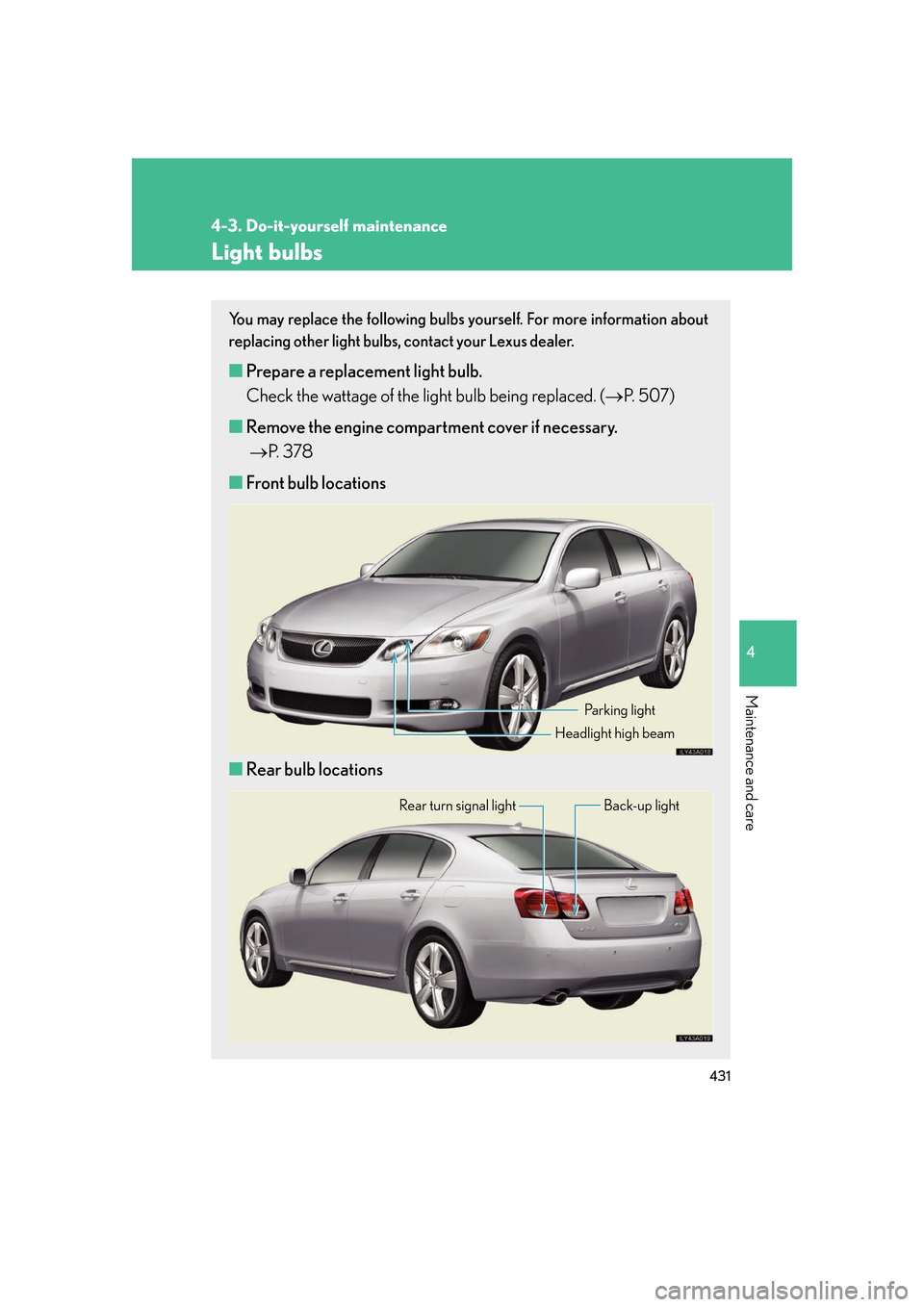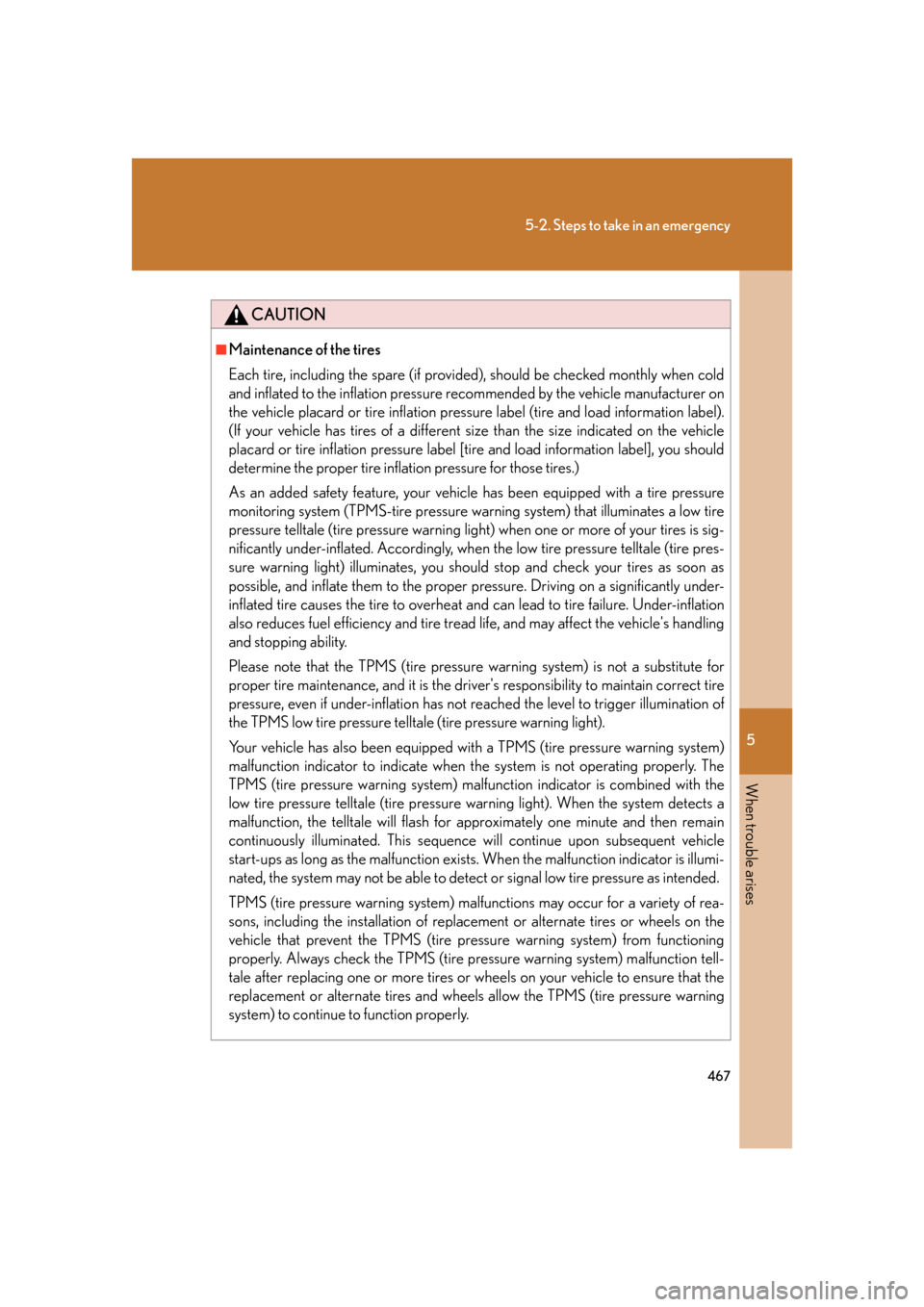maintenance Lexus GS350 2007 Using the front audio system / LEXUS 2007 GS430/350 (OM30A04U) Manual Online
[x] Cancel search | Manufacturer: LEXUS, Model Year: 2007, Model line: GS350, Model: Lexus GS350 2007Pages: 562, PDF Size: 17.95 MB
Page 451 of 562

431
4-3. Do-it-yourself maintenance
4
Maintenance and care
Light bulbs
You may replace the following bulbs yourself. For more information about
replacing other light bulbs, contact your Lexus dealer.
■Prepare a replacement light bulb.
Check the wattage of the light bulb being replaced. ( P
. 507)
■ R
emove the engine compartment cover if necessary.
P.
3 7 8
■ F
ront bulb locations
■Rear bulb locations
Parking light
Headlight high beam
Rear turn signal light Back-up light
Page 452 of 562

432
4-3. Do-it-yourself maintenance
Replacing light bulbs
■Headlight high beam
Unplug the connector while push-
ing the lock release.
Turn the bulb base counterclock -
wise to remove it.
STEP1
STEP2
Page 453 of 562

433
4-3. Do-it-yourself maintenance
4
Maintenance and care
■Parking light
Turn the bulb base counterclock-
wise.
Remove the light bulb.
■ B
ack-up light
Open the trunk lid. Remove the
trunk handle and panel co
ver clips.
Partly remove the trunk panel
co
ver and turn bulb bases coun -
terclockwise.
STEP1
STEP2
STEP1
STEP2
Page 454 of 562

434
4-3. Do-it-yourself maintenance
Remove the light bulb.
■ R
ear turn signal light
Open the trunk lid and remove the
co
ver.
Turn the bulb base counterclock -
wise.
Remove the light bulb.
STEP3
STEP1
STEP2
STEP3
Page 455 of 562

435
4-3. Do-it-yourself maintenance
4
Maintenance and care
■Bulbs other than the above
If any of the bulbs listed below has burnt out, have your Lexus dealer
r
eplace it.
● Headlight lo
w beams (high-intensity discharge bulbs)
● F
og lights
●F
ront turn signal lights
●F
ront side marker lights
●Stop
/tail lights
●T
ail lights
●R
ear side marker lights
●High mounted stoplight
● License plate lights
■Condensation build-up on the inside of the lens
Contact your Lexus dealer for more inform ation i
n the following situations. Tempo-
rary condensation build-up on the inside of the headlight lens does not indicate a
ma
lfunction.
●Large drops of water are built up on the inside of the lens.
●Water has built up in side the headlight.
■LED light bulbs
The tail, tail/stop and high mounted stopligh ts co
nsist of a number of LEDs. If any
LEDs burn out, take your vehicle to your Lexus dealer to have the light replaced.
If two or more LEDs in a stoplight burn out, y
our vehicle may not conform to local
laws (SAE).
■High-intensity discharge (HID) headlights
If voltage to the high-intensity discharge bu l
bs is insufficient, the light may not come
on, or may go out temporarily. The high-i ntensity discharge bulbs will come on
when normal power is restored.
Page 456 of 562

436
4-3. Do-it-yourself maintenance
CAUTION
■Replacing light bulbs
●Turn off the headlights. Do not attempt to replace the bulb immediately after turn-
ing off the headlights.
The bulbs become very hot and may cause burns.
●Do not touch the glass portion of the light bulb with bare hands. Hold the bulb by
the plastic or metal portion.
If the bulb is scratched or dropped it may blow out or crack.
●Fully install light bulbs and any parts used to secure them. Failing to do so may
result in heat damage, fire, or water ente ring the headlight unit. This may damage
the headlights or cause condensation to build up on the lens.
●Do not attempt to repair or disassemble lig ht bulbs, connectors, electric circuits
or component parts.
Doing so may result in serious injury due to electric shock.
■High-intensity discharge (HID) headlights
●Contact your Lexus dealer before replac ing high-intensity discharge headlights
(including light bulbs).
●Do not touch the high-intensity discharge headlight's high voltage socket when
the headlights are turned on. An extremely high voltage of 20000V will be dis-
charged and could result in serious injury or death by electric shock.
■To prevent damage or fire
Make sure bulbs are fully seated and locked.
Page 484 of 562

464
5-2. Steps to take in an emergency
Wa r n i n g m e s s a g eDetailsCorrection procedure
(U.S.A. only)
The engine oil is sched-
uled to be changed.
Check the engine oil, and
change if necessary.
Comes on approximately
4500 miles (7200 km)
after the engine oil is
changed. (The indicator
will not work properly
unless the oil mainte-
nance data has been
reset).
(U.S.A. only)
The engine oil should be
changed.
Check and change the
engine oil.
Comes on approximately
5000 miles (8000 km)
after the engine oil is
changed (and the oil
maintenance data has
been reset).
Low tire inflation pres-
sure.Check the tire inflation
pressure, and adjust to the
appropriate level.
Page 486 of 562

466
5-2. Steps to take in an emergency
Wa r n i n g m e s s a g eDetailsCorrection procedure
(Flashing)
(If equipped)
Yo u r v e h i c l e i s n e a r i n g
the vehicle ahead (in
radar cruise mode).Slow the vehicle by apply-
ing the brakes.
(Flashing)
The transmission is out of
“P” when attempting to
start the engine.Shift the shift lever to “P”
before pressing the
engine switch.
■After changing the engine oil (U.S.A. only)
Make sure to reset the oil maintenance data. ( P.
3 8 2 )
■Approach warning message
In the following instances, there is the possibil
ity that the approach warning will not
activate even when the vehicle-to-vehicle distance decreases.
●When your vehicle and the vehicle ahead are traveling at the same speed or the
vehicle ahead is traveling more quickly than your vehicle.
●When the vehicle ahead is traveling at a very low speed.
●Immediately after cruise control speed is set.
●At the instant the accelerator pedal is depressed.
Page 487 of 562

5
When trouble arises
467
5-2. Steps to take in an emergency
CAUTION
■Maintenance of the tires
Each tire, including the spare (if provided), should be checked monthly when cold
and inflated to the inflation pressure re commended by the vehicle manufacturer on
the vehicle placard or tire inflation pressure label (tire and load information label).
(If your vehicle has tires of a different size than the size indicated on the vehicle
placard or tire inflation pressure label [tire and load information label], you should
determine the proper tire inflation pressure for those tires.)
As an added safety feature, your vehicle has been equipped with a tire pressure
monitoring system (TPMS-tire pressure warning system) that illuminates a low tire
pressure telltale (tire pressure warning light) when one or more of your tires is sig-
nificantly under-inflated. Accordingly, when the low tire pressure telltale (tire pres-
sure warning light) illuminates, you should stop and check your tires as soon as
possible, and inflate them to the proper pressure. Driving on a significantly under-
inflated tire causes the tire to overheat an d can lead to tire failure. Under-inflation
also reduces fuel efficiency and tire tread life, and may affect the vehicle's handling
and stopping ability.
Please note that the TPMS (tire pressure warning system) is not a substitute for
proper tire maintenance, and it is the driver's responsibility to maintain correct tire
pressure, even if under-inflation has not reached the level to trigger illumination of
the TPMS low tire pressure telltale (tire pressure warning light).
Your vehicle has also been equipped with a TPMS (tire pressure warning system)
malfunction indicator to indicate when th e system is not operating properly. The
TPMS (tire pressure warning system) malf unction indicator is combined with the
low tire pressure telltale (tire pressure warning light). When the system detects a
malfunction, the telltale will flash for approximately one minute and then remain
continuously illuminated. This sequence will continue upon subsequent vehicle
start-ups as long as the malfunction exists . When the malfunction indicator is illumi-
nated, the system may not be able to detect or signal low tire pressure as intended.
TPMS (tire pressure warning system) malfunctions may occur for a variety of rea-
sons, including the installation of replacem ent or alternate tires or wheels on the
vehicle that prevent the TPMS (tire pressure warning system) from functioning
properly. Always check the TPMS (tire pressure warning system) malfunction tell-
tale after replacing one or more tires or wheels on your vehicle to ensure that the
replacement or alternate tires and wheels allow the TPMS (tire pressure warning
system) to continue to function properly.
Page 517 of 562

Vehicle specifications6
497
6-1. Specifications ......................... 498Maintenance data..................... 498
Fuel information........................ 508
Tire information ............................. 511
6-2. Customization ........................ 523 Customizable features ........... 523
6-3. Initialization ............................. 527 Items to initialize ........................ 527